Showing Spotlights 2217 - 2224 of 2783 in category All (newest first):
 Advanced material engineering techniques can structure surfaces that allow dynamic tuning of their wettability all the way from superhydrophobic (i.e. repelling) behavior to almost complete wetting (i.e. superhydrophilic or strongly absorbing) - but these surfaces only work with high-surface-tension liquids. Almost all organic liquids that are ubiquitous in human environment such as oils, solvents, detergents, etc. have fairly low surface tensions and thus readily wet even superhydrophobic surfaces. In a previous Spotlight we reported how researchers have been creating surfaces that would extend superhydrophobic behavior to all liquids, no matter what the surface tension. New work coming out of MIT now describes a novel nanostructures membrane that can be switched between superhydrophilic and superhydrophobic behavior on demand. Think of it as an 'oil spill clean-up paper towel' that absorbs only the oil but not the water. Given the global scale of severe water pollution arising from oil spills and industrial organic pollutants, this nanomaterial may prove particularly useful in the design of recyclable absorbents with significant environmental impact.
Advanced material engineering techniques can structure surfaces that allow dynamic tuning of their wettability all the way from superhydrophobic (i.e. repelling) behavior to almost complete wetting (i.e. superhydrophilic or strongly absorbing) - but these surfaces only work with high-surface-tension liquids. Almost all organic liquids that are ubiquitous in human environment such as oils, solvents, detergents, etc. have fairly low surface tensions and thus readily wet even superhydrophobic surfaces. In a previous Spotlight we reported how researchers have been creating surfaces that would extend superhydrophobic behavior to all liquids, no matter what the surface tension. New work coming out of MIT now describes a novel nanostructures membrane that can be switched between superhydrophilic and superhydrophobic behavior on demand. Think of it as an 'oil spill clean-up paper towel' that absorbs only the oil but not the water. Given the global scale of severe water pollution arising from oil spills and industrial organic pollutants, this nanomaterial may prove particularly useful in the design of recyclable absorbents with significant environmental impact.
May 30th, 2008
 Germany, with an almost 40% share of European public funded nanoscience research, is the clear nanotechnology leader in Europe. It is also one of the leaders globally in pushing research into potential risk and safety concerns associated with nanotechnology. The Federal Ministry of Education and Research (BMBF) is the ministry responsible for federal activities in the nanotechnology sector in Germany. Within its framework of 'leading-edge innovations' the BMBF supports key areas of nanotechnologies with promising prospects (NanoMobil, NanoChem, NanoFab, NanoforLife,NanoLux). The project NanoChance aims to support small and medium-sized companies in particular. The cooperative project NanoCare currently mainly focuses on studying possible risks of engineered nanoparticles. Beyond that, the federal agencies BAuA (Federal Institute for Occupational Safety and Health), UBA (Federal Environment Agency) and BfR (Federal Institute for Risk Assessment) have developed a joint research strategy that addresses especially health and environmental risks of engineered nanoparticles. The strategy has been finalized in December 2007 and a final report has just been published.
Germany, with an almost 40% share of European public funded nanoscience research, is the clear nanotechnology leader in Europe. It is also one of the leaders globally in pushing research into potential risk and safety concerns associated with nanotechnology. The Federal Ministry of Education and Research (BMBF) is the ministry responsible for federal activities in the nanotechnology sector in Germany. Within its framework of 'leading-edge innovations' the BMBF supports key areas of nanotechnologies with promising prospects (NanoMobil, NanoChem, NanoFab, NanoforLife,NanoLux). The project NanoChance aims to support small and medium-sized companies in particular. The cooperative project NanoCare currently mainly focuses on studying possible risks of engineered nanoparticles. Beyond that, the federal agencies BAuA (Federal Institute for Occupational Safety and Health), UBA (Federal Environment Agency) and BfR (Federal Institute for Risk Assessment) have developed a joint research strategy that addresses especially health and environmental risks of engineered nanoparticles. The strategy has been finalized in December 2007 and a final report has just been published.
May 29th, 2008
 Oscar Pistorius - also known as 'Blade Runner' - is a double leg amputee who is using specially developed artificial legs to compete in races. A world record holder in the 100, 200 and 400 meters Paralympic events, Pistorius was denied by the International Association of Athletics Federations (IAAF) his application to participate in the 2008 Summer Olympics. The IAAF argued that his prosthetic racing legs give him a clear competitive advantage. On May 16, the IAAF's decision was overturned by the Court of Arbitration for Sport, allowing Pistorius to participate in the Olympics if he could make the minimum qualifying time. This episode drives home the monumental issues our society will be facing in the not too distant future thanks to our increasing technological ability to enhance the human body. Terms like 'health', 'disease', 'therapy' and 'medicine' will have to be radically redefined.
Oscar Pistorius - also known as 'Blade Runner' - is a double leg amputee who is using specially developed artificial legs to compete in races. A world record holder in the 100, 200 and 400 meters Paralympic events, Pistorius was denied by the International Association of Athletics Federations (IAAF) his application to participate in the 2008 Summer Olympics. The IAAF argued that his prosthetic racing legs give him a clear competitive advantage. On May 16, the IAAF's decision was overturned by the Court of Arbitration for Sport, allowing Pistorius to participate in the Olympics if he could make the minimum qualifying time. This episode drives home the monumental issues our society will be facing in the not too distant future thanks to our increasing technological ability to enhance the human body. Terms like 'health', 'disease', 'therapy' and 'medicine' will have to be radically redefined.
May 28th, 2008
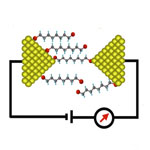 One of the many fascinating concepts in nanotechnology is the vision of molecular electronics where tomorrow's engineers might use individual molecules to perform the functions in an electronic circuit that are performed by semiconductor devices today. This is just another example of scientists taking a cue from nature's playbook, where essentially all electronic processes, from photosynthesis to signal transduction, occur in molecular structures. The basic science on which molecular electronics technology would be built is now unfolding but researchers are still struggling with the most basic requirements for molecular electronics, for instance, how to precisely position individual molecules on a surface or how to reliably measure the resistance of a single molecule. A tremendous amount of painstaking work goes into developing the kind of ultraprecise and ultrasensitive instruments that are required to develop electronics at the nanoscale. A recent example is a new device for measuring the conductance values of single-molecule junctions which are covalently bound to two electrodes.
One of the many fascinating concepts in nanotechnology is the vision of molecular electronics where tomorrow's engineers might use individual molecules to perform the functions in an electronic circuit that are performed by semiconductor devices today. This is just another example of scientists taking a cue from nature's playbook, where essentially all electronic processes, from photosynthesis to signal transduction, occur in molecular structures. The basic science on which molecular electronics technology would be built is now unfolding but researchers are still struggling with the most basic requirements for molecular electronics, for instance, how to precisely position individual molecules on a surface or how to reliably measure the resistance of a single molecule. A tremendous amount of painstaking work goes into developing the kind of ultraprecise and ultrasensitive instruments that are required to develop electronics at the nanoscale. A recent example is a new device for measuring the conductance values of single-molecule junctions which are covalently bound to two electrodes.
May 27th, 2008
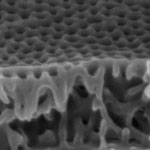 Separation and purification of bio-molecules such as proteins and viruses are important processes in the biotechnology industry. The risk of contamination with either known or unknown viruses in biological or therapeutic products require production processes that - ideally - completely eliminate the risks of virus contamination. Since the existence of very small amounts of viruses with a size of tens of nanometers causes severe damage to the entire bio-process, the filtration of viruses has to be pretty much perfect. Micro- and ultrafiltration have been successfully used in numerous processes as a robust step for virus reduction but they are not 100% effective. Currently used ultrafiltration membranes still allow smaller-sized virus particles to permeate into a small number of abnormally large-sized pores in the membrane. This broad size distribution of pores in ultrafiltration membranes and the low density of pores in track-etched membranes limit the practical use of virus filtration.
Separation and purification of bio-molecules such as proteins and viruses are important processes in the biotechnology industry. The risk of contamination with either known or unknown viruses in biological or therapeutic products require production processes that - ideally - completely eliminate the risks of virus contamination. Since the existence of very small amounts of viruses with a size of tens of nanometers causes severe damage to the entire bio-process, the filtration of viruses has to be pretty much perfect. Micro- and ultrafiltration have been successfully used in numerous processes as a robust step for virus reduction but they are not 100% effective. Currently used ultrafiltration membranes still allow smaller-sized virus particles to permeate into a small number of abnormally large-sized pores in the membrane. This broad size distribution of pores in ultrafiltration membranes and the low density of pores in track-etched membranes limit the practical use of virus filtration.
May 23rd, 2008
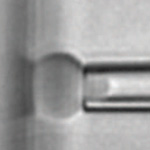 'Reverse engineering' is the process of discovering the technological principles of a device or system through analysis of its structure, function and operation, often by taking it apart and analyzing its workings in detail. This approach is a common practice among industrial companies who use it to analyze the competition's products, be it cars or MP3 players, to understand where the latest product improvements come from and how individual components are made. An increasing number of scientists apply a similar approach to nature's own 'micro- and nanotechnology' systems. They believe that learning from nature's designs and engineering successes is more likely to provide the cues for designing practical nanodevices than by simply applying a 'trial and error' approach. The basic idea is that natural materials and systems can be adopted for human use beyond their original purpose in nature. Some examples of 'reverse' biophysics work and have already proven quite useful, for instance the use of individual red blood cells as reliable, ultrasensitive mechanotransducers.
'Reverse engineering' is the process of discovering the technological principles of a device or system through analysis of its structure, function and operation, often by taking it apart and analyzing its workings in detail. This approach is a common practice among industrial companies who use it to analyze the competition's products, be it cars or MP3 players, to understand where the latest product improvements come from and how individual components are made. An increasing number of scientists apply a similar approach to nature's own 'micro- and nanotechnology' systems. They believe that learning from nature's designs and engineering successes is more likely to provide the cues for designing practical nanodevices than by simply applying a 'trial and error' approach. The basic idea is that natural materials and systems can be adopted for human use beyond their original purpose in nature. Some examples of 'reverse' biophysics work and have already proven quite useful, for instance the use of individual red blood cells as reliable, ultrasensitive mechanotransducers.
May 22nd, 2008
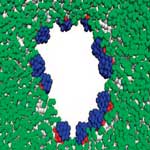 Nanotechnology researchers have appropriated the name of Janus - the Roman god of gates and doorways, usually depicted with two heads looking in opposite directions - to name a class of amphiphilic (i.e. containing both hydrophobic and hydrophilic portions) nanoparticles composed of two fused hemispheres, each made from a different substance. Their particular structure makes Janus particles an intriguing subject for exploring novel anti-cancer therapies where they, for instance, carry two different and complementary medicines. In a novel use of Janus particles, researchers have now isolated a means of using them to make 're-sealable' pores in lipid bilayer membranes. Described in another way, the localization of the nanoparticles in the pore can be thought of as the placement of a zipper, which allows a specific slit to be opened or closed at will.
Nanotechnology researchers have appropriated the name of Janus - the Roman god of gates and doorways, usually depicted with two heads looking in opposite directions - to name a class of amphiphilic (i.e. containing both hydrophobic and hydrophilic portions) nanoparticles composed of two fused hemispheres, each made from a different substance. Their particular structure makes Janus particles an intriguing subject for exploring novel anti-cancer therapies where they, for instance, carry two different and complementary medicines. In a novel use of Janus particles, researchers have now isolated a means of using them to make 're-sealable' pores in lipid bilayer membranes. Described in another way, the localization of the nanoparticles in the pore can be thought of as the placement of a zipper, which allows a specific slit to be opened or closed at will.
May 21st, 2008
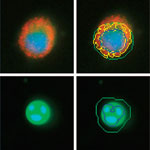 High content analysis (HCA) is a powerful platform that combines cell-based assays with traditional microscopy and automated, sophisticated image processing and analysis software. This technology is capable of using living and fixed cells, typically with fluorescently labeled antibodies and reagents. It has been widely adopted in the pharmaceutical and biotechnology industries for target identification and validation. HCA has made particular inroads into research and development applications where high throughput screening has proven inadequate, such as measuring multiple biological pathways simultaneously, or revealing off-target drug effects. HCA has stepped into this void by demonstrating how particular proteins are affected by the application of a molecule to the cell line of interest.
High content analysis (HCA) is a powerful platform that combines cell-based assays with traditional microscopy and automated, sophisticated image processing and analysis software. This technology is capable of using living and fixed cells, typically with fluorescently labeled antibodies and reagents. It has been widely adopted in the pharmaceutical and biotechnology industries for target identification and validation. HCA has made particular inroads into research and development applications where high throughput screening has proven inadequate, such as measuring multiple biological pathways simultaneously, or revealing off-target drug effects. HCA has stepped into this void by demonstrating how particular proteins are affected by the application of a molecule to the cell line of interest.
May 20th, 2008
 Advanced material engineering techniques can structure surfaces that allow dynamic tuning of their wettability all the way from superhydrophobic (i.e. repelling) behavior to almost complete wetting (i.e. superhydrophilic or strongly absorbing) - but these surfaces only work with high-surface-tension liquids. Almost all organic liquids that are ubiquitous in human environment such as oils, solvents, detergents, etc. have fairly low surface tensions and thus readily wet even superhydrophobic surfaces. In a previous Spotlight we reported how researchers have been creating surfaces that would extend superhydrophobic behavior to all liquids, no matter what the surface tension. New work coming out of MIT now describes a novel nanostructures membrane that can be switched between superhydrophilic and superhydrophobic behavior on demand. Think of it as an 'oil spill clean-up paper towel' that absorbs only the oil but not the water. Given the global scale of severe water pollution arising from oil spills and industrial organic pollutants, this nanomaterial may prove particularly useful in the design of recyclable absorbents with significant environmental impact.
Advanced material engineering techniques can structure surfaces that allow dynamic tuning of their wettability all the way from superhydrophobic (i.e. repelling) behavior to almost complete wetting (i.e. superhydrophilic or strongly absorbing) - but these surfaces only work with high-surface-tension liquids. Almost all organic liquids that are ubiquitous in human environment such as oils, solvents, detergents, etc. have fairly low surface tensions and thus readily wet even superhydrophobic surfaces. In a previous Spotlight we reported how researchers have been creating surfaces that would extend superhydrophobic behavior to all liquids, no matter what the surface tension. New work coming out of MIT now describes a novel nanostructures membrane that can be switched between superhydrophilic and superhydrophobic behavior on demand. Think of it as an 'oil spill clean-up paper towel' that absorbs only the oil but not the water. Given the global scale of severe water pollution arising from oil spills and industrial organic pollutants, this nanomaterial may prove particularly useful in the design of recyclable absorbents with significant environmental impact.
 Subscribe to our Nanotechnology Spotlight feed
Subscribe to our Nanotechnology Spotlight feed





